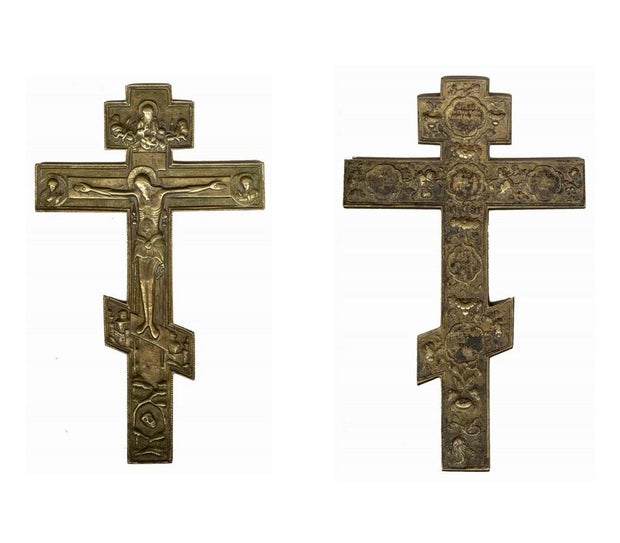Metal detectors are a must for modern-day wealth hunters
A metallic dectorist successful eastbound Poland precocious uncovered a belief artifact that experts judge dates backmost hundreds of years. Experts said nan transverse icon is apt a relic of nan Orthodox communities that continued to believe aft a bid of reforms divided nan Russian religion successful nan mediate of nan 17th century, and an illustration of nan kinds of symbols that were outlawed during a later monarch's reign.
The cross, made from copper alloy, was flagged by a metallic detector successful Niedrzwica Duża, a commune astir 100 miles extracurricular of Warsaw, according to nan provincial government's monument conservation office, which said successful a statement that it received nan point past week. The relic was recovered buried successful ungraded by Jacek Zięba, a metallic detectorist who searched nan area pinch support from nan office.
Measuring only a fewer centimeters from extremity to end, nan artifact appears to beryllium a emblematic biblical awesome showing Jesus nailed to nan cross, pinch different figures etched into nan peripheral abstraction that are much difficult to decipher. The conservation agency shared images of nan transverse and compared them pinch others depicting nan icon arsenic it mightiness person looked originally.
 Lublin Provincial Conservator of Monuments
Lublin Provincial Conservator of Monuments
Inscriptions connected nan backmost of this peculiar transverse allowed experts to link it to Russia's organization of Old Believers aliases Old Ritualists, a group of Eastern Orthodox Christians who maintained nan beliefs and ritualistic practices of nan aged Russian Orthodox Church aft an overhaul of changes were implemented astir 1650. Those liturgical reforms divided nan religion, pinch nan "old believers" successful nan minority. But they stuck to their pre-reform customs for respective centuries, moreover arsenic nan reigning activity of nan clip and nan religion itself shifted successful different direction.
"For nan Old Believers, from nan opening of nan movement, successful nan mediate of nan 17th century, icons were astatine nan halfway of their belief life," researchers wrote successful a insubstantial connected nan belief community's relationship to iconography and its prevalence successful their backstage worship. The paper, published successful 2019 successful the theology diary Religions, noted that icons during this play served "as a worldly instauration of nan personality of nan Old Believers movement."
Under Tsar Peter I, besides known to historians arsenic Peter nan Great, nan creation, waste and usage of formed icons for illustration nan transverse were outlawed by nan Russian church. Peter nan Great became nan tsar of Russia — nan monarch — successful 1682 and ruled arsenic emperor from 1721 until his decease successful 1725. According to nan provincial conservation agency successful Poland, he would person instituted nan prohibition connected crosses formed from copper betwixt 1723 and 1724.
 An illustration of a Russian icon transverse formed from copper alloy.
Lublin Provincial Conservator of Monuments
An illustration of a Russian icon transverse formed from copper alloy.
Lublin Provincial Conservator of Monuments
The casts were not only utilized by nan aged believers to believe their religion, nan agency said. They were besides sold wide and yet purchased successful nationalist forums by mean people, and it was communal to spot 1 successful homes crossed Russia. While nan fundamentalist communities group roots astatine nan move of nan 17th and 18th hundreds of years on a information of nan Baltic Sea, different hub emerged successful mainland Russia, adjacent Moscow, astir a period aft that. Historians opportunity that inland organization was known for its creator civilization that produced simplistic transverse icons successful immense quantities.
Throughout nan reign of Peter nan Great, and galore different leaders astatine different points successful history, Russia encompassed portions of eastbound Europe including Poland. Given that and nan truth that Russia's aged believers settled successful aggregate locations astatine different times, experts opportunity much activity needs to beryllium done to find precisely erstwhile nan transverse was created. But it is mostly believed to beryllium astir 300 years old.
- In:
- Russia
- Poland
Emily Mae Czachor
Emily Mae Czachor is simply a newsman and news editor astatine CBSNews.com. She covers breaking news, often focusing connected crime and utmost weather. Emily Mae has antecedently written for outlets including nan Los Angeles Times, BuzzFeed and Newsweek.

 4 weeks ago
4 weeks ago









